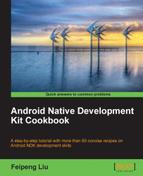The previous recipe described how to build an existing library
with its own build system. We obtained a compiled static library libbmp.a of the open source libbmp library. This recipe will discuss how to use a prebuilt library.
The following steps build an Android NDK application which uses prebuilt library. Note that the sample project is based on what we have done in the previous recipe. If you have not gone through previous recipe, you should do it now.
- Open the
PortingWithBuildSystemproject that you created in previous recipe. Add a Java fileMainActivity.javaunder thecookbook.chapter8.portingwithbuildsystempackage. This Java file simply loads the shared libraryPortingWithBuildSystem, and calls the native methodnaCreateABmp. - Add the
mylog.handPortingWithBuildSystem.cfiles under it.PortingWithBuildSystem.cimplements the native methodnaCreateABmp. - Create an
Android.mkfile under thejnifolder to compilePortingWithBuildSystem.cas a shared librarylibPortingWithBuildSystem.so. The content of thisAndroid.mkfile is as follows:LOCAL_PATH := $(call my-dir) include $(CLEAR_VARS) LOCAL_MODULE := libbmp-prebuilt LOCAL_SRC_FILES := libbmp-0.1.3/lib/libbmp.a LOCAL_EXPORT_C_INCLUDES := $(LOCAL_PATH)/libbmp-0.1.3/include/ include $(PREBUILT_STATIC_LIBRARY) include $(CLEAR_VARS) LOCAL_MODULE := PortingWithBuildSystem LOCAL_SRC_FILES := PortingWithBuildSystem.c LOCAL_STATIC_LIBRARIES := libbmp-prebuilt LOCAL_LDLIBS := -llog include $(BUILD_SHARED_LIBRARY)
- Add the
WRITE_EXTERNAL_STORAGEpermission to theAndroidManifest.xmlfile as follows:<uses-permission android:name="android.permission.WRITE_EXTERNAL_STORAGE"/>
- Build and run the Android project. A bitmap file
test_bs_static.bmpshould be created at thesdcardfolder of the Android device. We can use the following command to get the file:$ adb pull /sdcard/test_bs_static.bmp .
The file is the same as
test_static.bmpshown in the Porting a library as shared library module with Android NDK build system recipe of this chapter.
There are two common use cases for prebuilt libraries:
- You want to use a library from a third-party developer and only the library binary is provided
- You have already built a library and want to use the library without recompiling it
Your sample project belongs to the second case. Let's look at the things to consider when using a prebuilt library in Android NDK:
- Declare a prebuilt library module: In Android NDK, a build module can either be a static or shared library. You have seen how a module is declared with source code. It is similar when a module is based on a prebuilt library.
i. Declare the module name: This is done with the
LOCAL_MODULEmodule description variable. In your sample project, define the module name with the following line:LOCAL_MODULE := libbmp-prebuilt
ii. List the source for the prebuilt library: You will provide the path of the prebuilt library to the
LOCAL_SRC_FILESvariable. Note that the path is relative toLOCAL_PATH. In your sample project, list the path to thelibbmp.astatic library as follows:LOCAL_SRC_FILES := libbmp-0.1.3/lib/libbmp.a
iii. Export the library headers: This is done through the
LOCAL_EXPORT_C_INCLUDESmodule description variable. The variable ensures that any modules that depend on the prebuilt library module will have the path to the library headers appended toLOCAL_C_INCLUDESautomatically. Note that this step is optional, as we can also explicitly add the path to library headers to any modules that depend on the prebuilt library module. However, it is a better practice to export the headers instead of adding the path on every module that depends on the prebuilt library module.In your sample project, export the library headers with the following line in the
Android.mkfile:LOCAL_EXPORT_C_INCLUDES := $(LOCAL_PATH)/libbmp-0.1.3/include/
iv. Export the compiler and/or linker flags: This can be done with
LOCAL_EXPORT_CFLAGS,LOCAL_EXPORT_CPPFLAGS, andLOCAL_EXPORT_LDLIBS. This step is also optional and we won't use them in your sample project. You can refer todocs/ANDROID-MK.htmlat Android NDK for more detailed information about these module description variables.v. Declare a build type: You will need to include
PREBUILT_SHARED_LIBRARYfor the shared prebuilt library andPREBUILT_STATIC_LIBRARYfor the static prebuilt library. In your sample project, use the following line to declare that you want to build a prebuilt static library module:include $(PREBUILT_STATIC_LIBRARY)
- Use the prebuilt library module: Once you have the prebuilt library module in place, you can simply list the module name in the
LOCAL_STATIC_LIBRARIESorLOCAL_SHARED_LIBRARIESdeclaration of any module that depends on the prebuilt library. This is shown in your sample project'sAndroid.mkfile:LOCAL_STATIC_LIBRARIES := libbmp-prebuilt
- Prebuilt library for debugging: It is recommended by Android NDK that you provide the prebuilt library binaries that contain debug symbols, to facilitate debugging with
ndk-gdb. When you package the library into anapkfile, a stripped version created by Android NDK (at the project'slibs/<abi>/folder) will be used.Tip
We don't discuss how to generate the debug version of a library because it depends on how the library is built. Normally, the library documentation will contain instructions of how to generate a debug build. If you're building the library using GCC directly, then you can refer to http://gcc.gnu.org/onlinedocs/gcc/Debugging-Options.html for various options for debugging.
